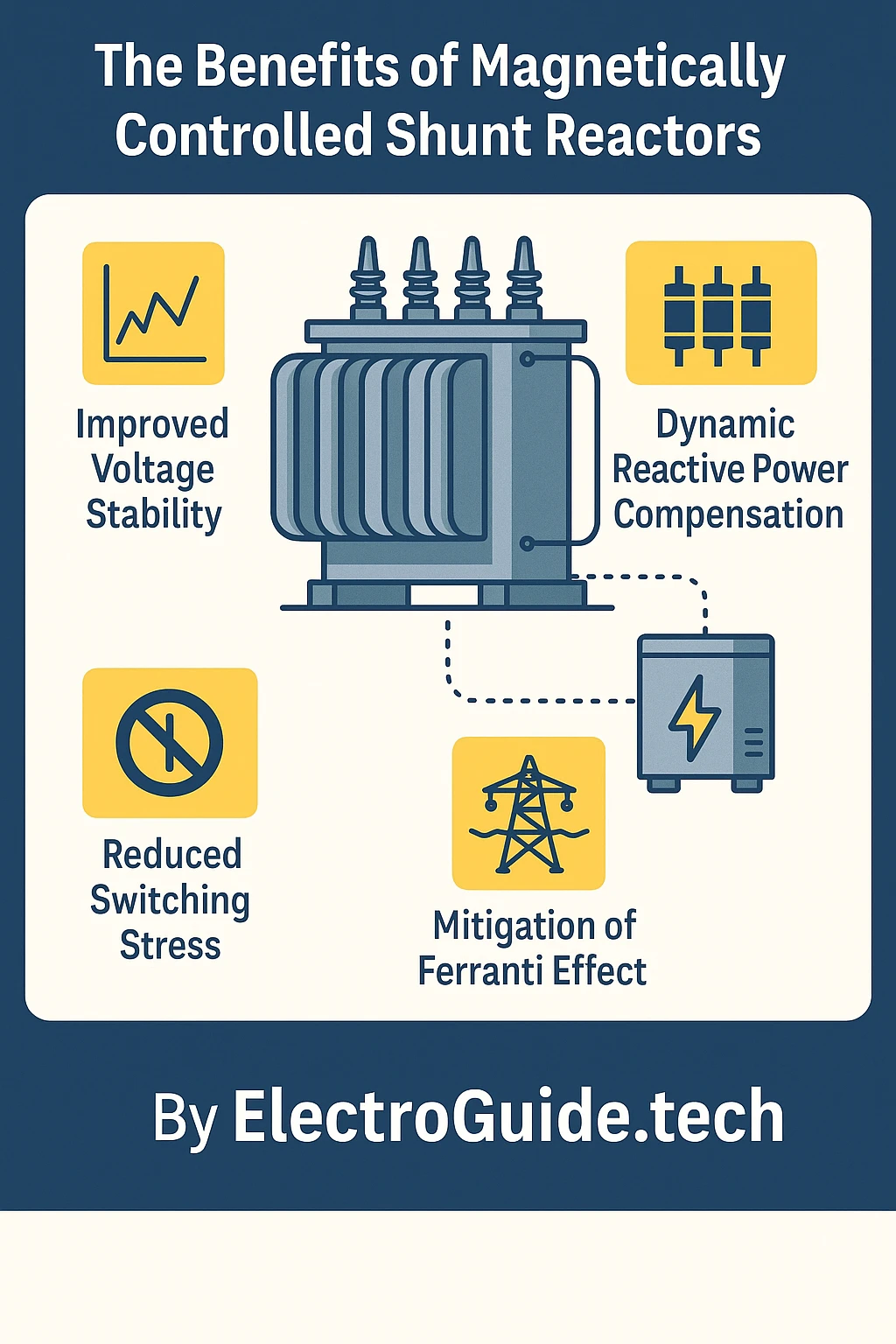By ElectroGuide.tech
📑 Table of Contents
- What is a Magnetically Controlled Shunt Reactor (MCSR)?
- Why Reactive Power Compensation is Crucial
- How MCSR Works: Design and Control Principles
- MCSR vs Fixed Shunt Reactors
- Applications of MCSR in HV and EHV Substations
- MCSR Impact on Ferranti Effect and Voltage Stability
- Capacitor Banks vs MCSRs: Which to Choose?
- Harmonic Filtering in Capacitor Banks
- Installation Considerations for MCSR in Substations
- Final Thoughts and Future Scope
🔍 What is a Magnetically Controlled Shunt Reactor (MCSR)?
A Magnetically Controlled Shunt Reactor (MCSR) is an advanced type of shunt reactor whose reactive power absorption can be dynamically controlled using magnetically regulated core saturation. MCSRs are increasingly used in HV and EHV substations (220kV, 400kV and above) for:
- Reactive power compensation
- Voltage stability enhancement
- Dynamic grid control
Unlike conventional fixed shunt reactors, MCSRs offer variable inductive compensation without mechanical switching, making them a preferred solution in modern smart grid systems.
⚙️ Why Reactive Power Compensation is Crucial
Reactive power is essential for voltage regulation in AC systems. Over long transmission distances, especially under low load conditions, the line capacitance can lead to an excessive voltage rise — known as the Ferranti effect. Without proper compensation, this can:
- Damage equipment
- Cause insulation stress
- Lead to protection malfunctions
MCSRs help absorb excess reactive power, stabilizing voltage levels effectively.
🧠 How MCSR Works: Design and Control Principles
An MCSR typically consists of:
- A three-phase core-type magnetic structure
- A main winding connected to the power system
- A control winding excited by a DC current source via a controlled rectifier
🎯 Working Principle:
- By changing the control current, the magnetic permeability of the core is altered.
- This changes the inductance of the reactor dynamically.
- Thus, the MCSR can continuously adjust its reactive power absorption without disconnecting from the grid.
This dynamic behavior eliminates the need for circuit breakers and enables fast, loss-minimized voltage control.
⚖️ MCSR vs Fixed Shunt Reactors
| Feature | Fixed Shunt Reactor | Magnetically Controlled Shunt Reactor |
|---|---|---|
| Reactive power control | Static | Dynamic |
| Switching stress | High | Low (No switching) |
| Ferranti effect mitigation | Partial | Excellent |
| Harmonic generation | Minimal | Minimal |
| Cost | Lower initial cost | Higher initial, but better ROI |
🏗️ Applications of MCSR in HV and EHV Substations
MCSRs are increasingly deployed in:
- 400 kV transmission lines to suppress voltage rise
- Substations at load centers to manage real-time reactive load
- Interconnected grids (cross-country/cross-region)
- Wind and solar farms for grid integration
They are ideal where load flow reversal or variable load conditions are frequent.
Example: A 500 kV, 180 MVA MCSR is being deployed in Russia’s 1000 km AC interconnection line to regulate voltage and enhance dynamic stability.
📈 MCSR Impact on Ferranti Effect and Voltage Stability
Overvoltage caused by line capacitance can exceed 110% of rated voltage under light load or no-load conditions. MCSRs:
- Absorb surplus reactive power near the receiving end
- Prevent voltage rise in long-distance transmission lines
- Maintain voltage within acceptable limits (±5%)
With continuous controllability, MCSRs outperform traditional reactors in mitigating the Ferranti effect.
⚔️ Capacitor Banks vs MCSRs: Which to Choose?
| Aspect | Shunt Capacitor Bank | Magnetically Controlled Shunt Reactor |
|---|---|---|
| Purpose | Supply reactive power | Absorb reactive power |
| Location | At load ends/substations | Typically at transmission ends |
| Harmonic susceptibility | High (requires filters) | Low |
| Cost-effectiveness | High for small systems | Better for EHV, long-distance lines |
MCSRs are not a replacement for capacitor banks but serve as a complementary solution for reactive power balancing.
🔊 Harmonic Filtering in Capacitor Banks
While MCSRs do not introduce significant harmonics, shunt capacitor banks are prone to harmonic resonance. Thus:
- Install harmonic filters in parallel with capacitor banks
- Use detuned reactors to shift resonance frequencies
These improve power quality and equipment lifespan, especially in industrial substations.
🛠️ Installation Considerations for MCSR in Substations
Before deploying MCSR:
- Evaluate system voltage profile under no-load/light-load
- Consider control integration with SCADA/EMS systems
- Assess substation layout and space availability
- Plan for cooling, protection relays, and bushing configuration
Standards such as IEC 60076-6 or IEEE C57.21 can guide MCSR specification.
🧾 Final Thoughts and Future Scope
Magnetically Controlled Shunt Reactors are emerging as key tools for modern grid challenges like:
- Dynamic voltage support
- Ferranti effect suppression
- Grid reliability in power-export/import regions
With increasing EHV/UHV interconnections and renewable penetration, MCSRs offer cost-effective, flexible, and low-loss solutions.
🔗 External High-Authority References
- Magnetically Controlled Shunt Reactor – Wikipedia
- Ferranti Effect – Wikipedia
- NREC Case Study on MCSR Use in 500kV Lines
- IEEE Tutorial on FACTS Devices
